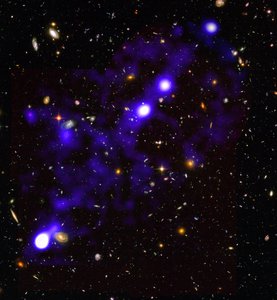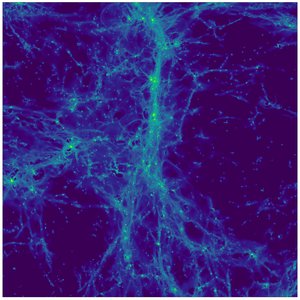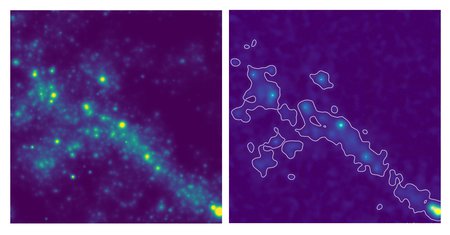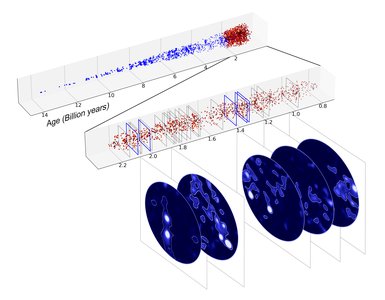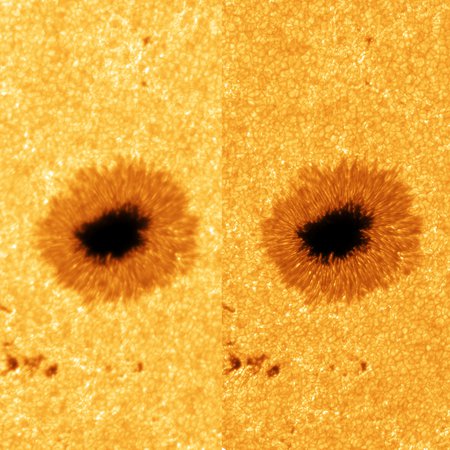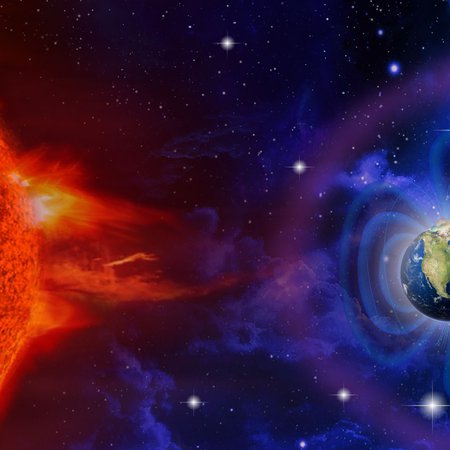MUSE discovers cosmic web filaments in the Hubble Ultra-Deep Field
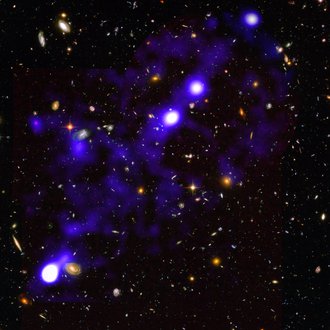
One of the ionised hydrogen filaments (in blue) discovered by MUSE in Hubble's ultra-deep field. It is located in the Fornax constellation, 11.5 billion light-years away and extends over 15 million light-years. The image in the background is that of Hubble.
Credit: Roland Bacon, ESO and NASAAstronomers in an international team including the Leibniz Institute for Astrophysics Potsdam (AIP) for the first time directly mapped cosmic web filaments in the young universe, less than two billion years after the Big Bang. The observations uncovered faint galaxies in the young universe which shed light on their possible ancestors.
The existence of the cosmic web, a web of large filamentary structures of gas within which galaxies form, is one of the major predictions of current models of the formation of structure in the universe, but it is also extremely difficult to observe. It was predicted forty years ago that the hydrogen gas in the cosmic web should emit an extremely faint fluorescent glow. Yet the expected signal is so faint that observing it has only very recently become possible, thanks to the Multi Unit Spectroscopic Explorer (MUSE) instrument at the Very Large Telescope of the European Southern Observatory. Until now only regions around bright quasars whose intense radiation boosts the fluorescent signal have shown bits and pieces of the cosmic web. But bright quasars are located in very dense and rare environments which are not representative of the normal filaments where most galaxies form. These filaments have so far remained undetected.
An international team led by Roland Bacon (CNRS, CRAL) and including several researchers based at the AIP has now been able to overcome this observational challenge. They performed a 140-hour exposure in a single spot of the iconic Hubble Ultra-Deep Field, using MUSE and its wide-field adaptive optics system. Dr. Peter Weilbacher, member of the team and responsible for the MUSE data reduction software, describes this as “the deepest spectral observation ever performed, using the most advanced spectroscopic facility in the world.”
The number density of galaxies found in this small field is more than a hundred times larger than what is normally seen in a classical galaxy survey. Forty percent of the detected galaxies are so faint that they are invisible in the images of the Hubble Space Telescope — even though Hubble has studied this field to greater depth than any other region.
The MUSE observations allowed the team to obtain the first ever maps of cosmic web filaments in the young universe, less than two billion years after the Big Bang. But what they found was not what they expected to find. A lot of the seemingly diffuse light from the filaments – maybe even most of it – comes from an “ocean” of ultra-faint galaxies which cannot be seen individually, but that together produce an extended diffuse-looking glow. “This really caught us by surprise”, says Prof. Lutz Wisotzki, head of the AIP section Galaxies and Quasars, who was involved in the interpretation of the results. “It appears as if there is much less gas filling the almost empty space between galaxies than we expected.” Dr. Tanya Urrutia, also of AIP, adds that “on the other hand we may now see for the first time the collective light from tiny clumps of freshly formed stars in the early universe that over cosmic time grew into becoming real galaxies.” Whatever the origin of the observed filamentary emission, these record-breaking deep images of the cosmic web greatly advance knowledge about the formation of galaxies and how they interact with their environment. In the coming years the team plans to conduct more observations with MUSE to further disentangle the mysteries of the cosmic web.Astronomers in an international team including the Leibniz Institute for Astrophysics Potsdam (AIP) for the first time directly mapped cosmic web filaments in the young universe, less than two billion years after the Big Bang. The observations uncovered faint galaxies in the young universe which shed light on their possible ancestors.
Further information
Originalpublikation
R. Bacon, D. Mary, T. Garel, J. Blaizot, M. Maseda, J. Schaye, L. Wisotzki, S. Conseil, J. Brinchmann, F. Leclercq, V. Abril-Melgarejo, L. Boogard, N. Bouché, T. Contini, A. Feltre, B. Guideroni, C. Herenz, W. Kollatschny et al. (2021): The MUSE Extremely Deep Field: The cosmic web in emission at high redshift. Astronomy & Astrophysics
DOI: https://doi.org/10.1051/0004-6361/202039887
Press release of the Centre for Astronomical Research of Lyon (CRAL)
https://www.cnrs.fr/en/first-images-cosmic-web-reveal-myriad-unsuspected-dwarf-galaxies
Images
One of the ionised hydrogen filaments (in blue) discovered by MUSE in Hubble's ultra-deep field. It is located in the Fornax constellation, 11.5 billion light-years away and extends over 15 million light-years. The image in the background is that of Hubble.
Big screen size [1000 x 1082, 160 KB]
Original size [2041 x 2209, 590 KB]
Cosmological simulation of the distant universe. This image illustrates the light emitted by the Hydrogen atoms of the cosmic web in a region of about 15 million light years sideways. In addition to the very low emission of the inter-galactic gas we can guess multiple point sources which are galaxies forming their first stars.
Big screen size [1000 x 1000, 150 KB]
Original size [7087 x 7087, 2.6 MB]
Cosmological simulation of a filament composed of hundreds of thousands of small galaxies. The image on the left is that of the radiation produced by all the galaxies as it could be observed in situ. The image on the right shows the filament as it would be observed by MUSE. Even with a very long exposure time, the vast majority of galaxies are not individually detectable, but the light from all these small galaxies is detected as a diffuse background, a bit like the Milky Way when observed with the naked eye.
Big screen size [1000 x 524, 60 KB]
Original size [4432 x 2323, 680 KB]
The 2250 galaxies observed by MUSE are displayed here according to the age of the universe (in billions of years). The period of the young universe, from 0.8 to 2.2 billion years, explored in this study, is represented in red. The 22 regions of galaxy over-density are marked by grey rectangles. The filament images of the 5 most statistically significant regions are shown in blue.
Big screen size [1000 x 779, 90 KB]
Original size [5034 x 3922, 870 KB]
